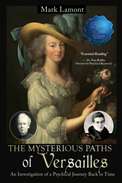
 |
The Mysterious Paths of Versailles: An Investigation of a Psychical Journey Back in Time
by Mark Lamont
BookVenture Publishing LLC
Ghost hunting—that is, the investigation of paranormal activity—has an enduring popularity. Witnesses claim supernatural experience, and third parties seek to verify or debunk their claims. Using historical research, scientific inquiry, and other scholarly methods, investigators comb through hard evidence that they pair with the anecdotal reports of eyewitnesses to unexplainable phenomenon. Despite exhaustive work, answers are elusive. Such is the case in this meticulously researched book that details the event, response, and potential explanations for an alleged incidence of the supernatural in 1901 at Versailles in France.
Two respectable British women of noted lineage, a principal and vice principal from a reputable school, claimed that while on holiday they visited a place on the grounds of the Palace of Versailles called Le Petit Trianon and came to believe they had journeyed back in time and encountered an altered state of reality. A decade later, the two women published a successful and well-received pseudonymous book about their experience. It remained in print through five subsequent editions and was only discontinued in the 1970s. Mainstream and alternative reviews were largely positive—though, given the attention that their work received, skepticism abounded as well, with unconfirmed reports of hoaxes, confessions, and other critical speculation.
What the women did or didn't see, and whether their story is phony or genuine, is certainly interesting to contemplate. Visualizing two turn-of-the-century English schoolmarms touring the French countryside only to encounter time-hopping men in three-cornered hats and Marie Antoinette herself is colorful stuff, and it's easy to see why their original book held such appeal for contemporary readers. However, the most intriguing part of this new book is its author's fascination with this minor 100-year-old story. Scholarship of any kind requires a degree of fixation that drives a person to commit to and excavate every last detail of its topic. What about these ladies' experience and documentation presents such compelling fodder for this author? Is he propelled by the juxtaposition of upright English ladies selling a ghost story? Is he hooked by the enduring way the reading world embraced and considered the authors' supernatural version of events? Is this story a historian's double scoop, combining analysis of the times of both Marie Antoinette and early 20th century Versailles down to the detail? Or is this simply an irresistible ghost hunt?
As the author capably leads through layers of inquiry, painstakingly introducing the players, setting the scene, reviewing past accounts and known historical minutiae from architecture to gardening details, the book's real energy center explodes with its exhaustive analysis of theories for paranormal phenomenon. From physics to the far-out metaphysical, the interpretations for a ghostly encounter seem infinite, and the detailed inventory of these theories could apply to any investigation, not just that of the Le Petit Trianon visitors. In the end, however, as with any ghost hunt, the conflation of scientific facts and supernatural theories only take the inquiry so far. The author concedes, as ghost hunters do, that whatever anecdotal oddity occurred at Versailles more than 100 years ago remains now and likely forever open to personal interpretation. The joy, it seems, is in contemplating the possibilities.